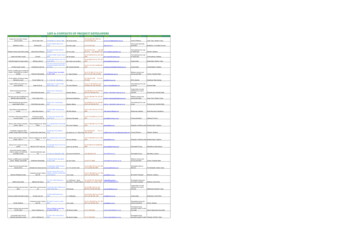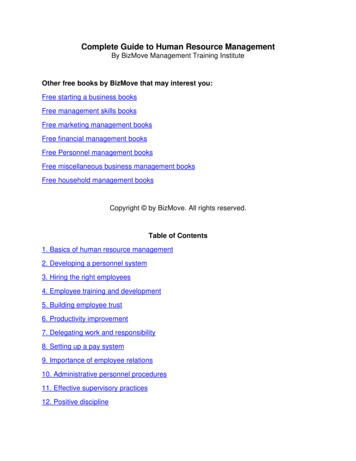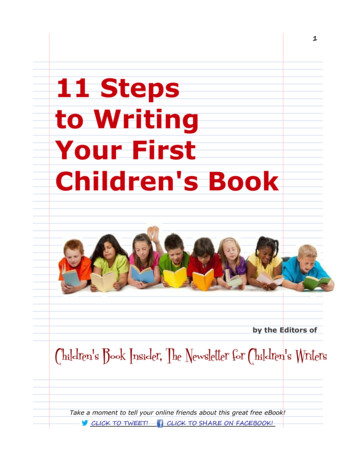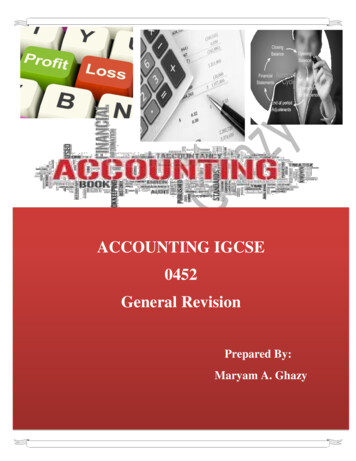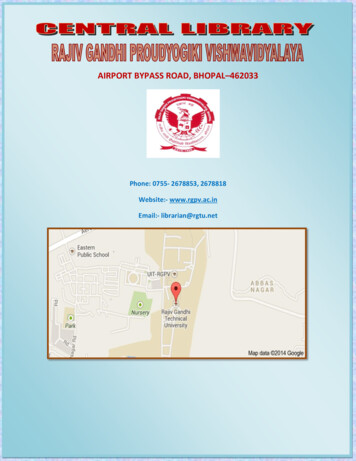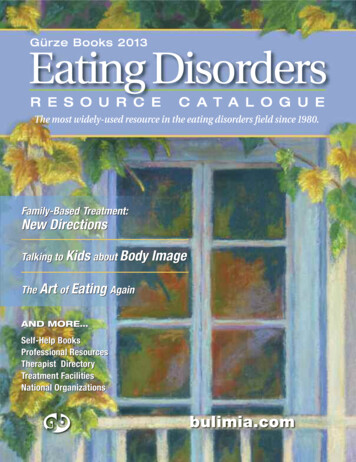
Transcription
Gürze Books 2013Eating DisordersR E S O U R C EC A T A L O G U EThe most widely-used resource in the eating disorders field since 1980.Family-Based Treatment:New DirectionsTalking to Kids about Body ImageThe Art of Eating AgainAND MORE Self-Help BooksProfessional ResourcesTherapist DirectoryTreatment FacilitiesNational Organizationsbulimia.com
WELCOMEServing theEating DisordersCommunitySince 1980eBooksOnlineGürze Books is dedicated to providing qualityinformation on eating disorders recovery,research, education, advocacy and prevention.It is owned by Lindsey Hall and Leigh Cohn,who wrote the first publication on bulimiaand have continued to write and publish inthe field ever since.bulimia.comeBooksOver 350 booksand DVDs withfull descriptionsQuick Linkswith selectbooks andfree articlesBlogsLinks to 50ED organizationsMoreinformationfor parentsLinks toED therapists& ersReview.comAbout the PaintingsFrancesca Droll from Abacus Graphics has designed this catalogue for close to 20 years. In additionto her graphic skills, she is a talented painter, whose soft pastels fill this year’s pages.For more information about her artwork, visit francescadroll.com.Text 2013 Gürze Books, PO Box 2238, Carlsbad, CA 92018, bulimia.comArtwork 2013 Francesca Droll, FrancescaDroll.com
ABOUTEating disorders are extreme expressions of a range ofweight and food issues experienced by both men andwomen. Although they currently fall into three distinctdiagnostic categories (which are evolving), individuals commonly have symptoms of more than one type of eatingdisorder at a time. All are serious medical and psychologicalproblems with potentially life-threatening consequences.Anorexia Nervosa is characterized by low weight due torestrictive eating and/or purging and an intense fear of being“fat.” The individual denies the seriousness of their low weighteven when emaciation is clear to others. About 1% of womenand .3% of men in the general population meet the criteria.*Bulimia (also called bulimia nervosa) typically refers tobinge-eating followed by compensatory weight-loss behaviorsof a purging (e.g., self-induced vomiting, diuretic or laxativeabuse) or non-purging (e.g. restricting, excessive exercise)nature. Although individuals with bulimia are usually withina healthy weight range, they are preoccupied by food, weight,and body concerns. About 1.5% of women and .5% of menhave bulimia.Binge Eating Disorder (sometimes called compulsiveeating) is characterized by repeated periods of impulsivegorging or continuous eating without regular compensatorybehaviors. About 3.5% of women and 2% of men meet theclinical diagnosis of binge eating disorder.Eating Disorders Not Otherwise Specified (EDNOS) is adiagnosis for individuals who meet some—but not all—ofthe criteria for one of the other eating disorders. Many morepeople fall into this category than the other three.Other Eating Disorders are quite rare, and they include pica,rumination, and Avoidant/Restrictive Food Intake Disorder.Causes of eating disorders are multidimensional andinclude genetics, family background, trauma, and our culture’sidealization of thinness.Symptoms include depression, low self-esteem, poorbody image, anxiety, loneliness, problems with relationships,and obsession with food and weight.Disordered Eating Behaviors such as restricting, bingeing, and purging that are initially a method of coping withpainful feelings and situations become habitual, underminingphysical health, self-esteem, and a sense of competence andcontrol.Professional treatment to understand and overcomethe underlying causes, symptoms, and behaviors is usuallyrecommended.* All prevalence figures cited from: Hudson, J., Hiripi, E., Pope, H. & Kessler, R.(2007). The prevalence and correlates of eating disorders in the national comorbidity survey replication. Biological Psychiatry, 61, 348-358.The Body BetrayedA Deeper Understandingof Women, Eating Disorders,and TreatmentKathryn J. Zerbe447 pg, paper, ’93 (Code: TBB) 18.95100 Questions & AnswersAbout Eating DisordersCarolyn Costin160 pg, paper, ’07(Code: OQA) 24.95Eating Disorder SourcebookThird EditionCarolyn Costin336 pg, paper, ’07 (Code: EDS) 17.95Do You Have an Eating Disorder?Respond honestly to these questions. Do you: Constantly think about your food, weight, or body image? Have difficulty concentrating because of those thoughts? Worry about what your last meal is doing to your body? Experience guilt or shame around eating? Count calories or fat grams whenever you eat or drink? Feel “out of control” when it comes to food? Binge eat twice a week or more? Still feel fat when others tell you that you are thin? Obsess about the size of specific body parts? Weigh yourself several times daily? Exercise to lose weight even if you are ill or injured? Label foods as “good” and “bad?” Vomit after eating? Use laxatives or diuretics to keep your weight down? Severely limit your food intake?If you answered “yes” to any of these questions, your attitudes andbehaviors around food and weight may need to be seriously addressed.An eating disorders professional can give you a thorough assessment,honest feedback, and advice about what you may want to do next.WARNING SIGNS An obvious increase or decrease in weight not related to a medical condition Abnormal eating habits such as severe dieting, ritualized mealtime behaviors,fear of dietary fat, secretive bingeing, or lying about food An intense preoccupation with weight and body image Mood swings, depression, irritability Compulsive or excessive exercising, especially without adequate nutritionalintake or when injured or ill800-756-7533 bulimia.com 3SOURCEBOOKSEATING DISORDERS
ANOREXIA NERVOSAThe Experience ofAnorexia colors one’s entire experience of living, notonly ravaging the body, but the mind and spirit aswell. Although dieting behaviors may have begunas a way to gain self-esteem and feelings of mastery, theyinsidiously escalate into a prison of painful thoughts andconfused emotions.Weight gain is essential for successful recovery, becauseof the physical, mental, and emotional changes associatedwith dramatic weight loss. Sufferers cannot think clearlyenough to make good decisions, problem-solve, feelmotivated, or reap the full benefits of therapy. They aretrapped in harmful thought patterns, such as “black andwhite” thinking, where everything is divided into extremecategories. Foods are labeled either “good” or “bad,” bodiesare either “fat” or “thin,” and not being completely in-controlmeans being completely out-of-control. There is no middleground. Other habitual, negative thought patterns aremagnifying problems, magical thinking, and taking remarksor situations too personally.These thinking patterns are rooted in deeply-heldbeliefs, which make change extremely difficult. Anorexicstypically believe that they can only be happy if they arethin, and that self-indulgence is a sign of weakness. Mostdevastating of all is the underlying belief in their own worthlessness, which is inextricably tied to the size of their bodies.“I am fat and fat is bad,” or, “I am bad if I eat.” These beliefsmake it possible for individuals with anorexia to deny theirreal needs for nourishment and self-nurturing.Not only are thought patterns affected by starvation, butfeelings are affected as well. One common assumption is thatanorexia “numbs” emotions, but this is not entirely true. Itis probably more accurate to say that anorexic symptomstranslate painful or unacceptable emotions into thoughts andfeelings having to do with food and the body. Unfortunately,anorexia comes with its own share of shame, loneliness,and fears, which are then layered over the original negativefeelings.Even the experience of success that accompanies thesuperhuman willpower to not eat is tempered with selfdoubt. Individuals with anorexia think they can never be thinenough or as good at doing anything other than losingweight. Sometimes, other people complicate this issue bycomplementing them on their thinness by saying thingslike, “You look great. I wish I could lose weight like you.”Recovering anorexics must learn that this type of response istypical in a culture that values thinness to such a degree, andthat lasting success is not measured by external standards—like the size of one’s body. Real success is based on how onethinks and feels on the inside.from Anorexia Nervosa: A Guide to Recoveryby Lindsey Hall & Monica OstroffAnorexia Nervosa:A Guide to RecoveryLindsey Hall & Monika Ostroff190 pg, paper, ’98(Code: ANO) 13.95Descriptions of morethan 350 books atbulimia.comAlso Available in Spanish“Recovering from an eating disorder requiresmore than simply reading a self-help book.It requires determination, hard work,and the involvement of others.by Hall & Ostroff4 Request free copies of the 2013 Gürze Eating Disorders Resource Catalogue”
THE ART OFAfter a long, long time being ill with anorexia, one of the MonteNido clients writes this about how you begin to eat again “I think you pick up your fork no matter how much your handis shaking and how many tears are pouring down your face and youput the food in your mouth and chew. Chew as long as it takes, andonce you swallow breathe. Take it slow at first, allow yourself to cry,to feel horrible, but remember why you are doing it. Because you arehoping for life, because you want to be at your sisters wedding,because you want to go to the beach with your best friend. Write itdown, look at it while you chew, have someone with you to remindyou. Keep doing this until it gets easier, and it will, I promise.Eventually you won’t need to write it down or have someone remindyou all the time, eventually you’ll be able to stop shaking, to talk, tolaugh, to eat with your best friend ON THE WAY to the beach. Soonyou will realize the pain that caused you to stop eating can be dealtwith and passes, and you learn to move forward, learning from thatpain, eating and laughing and living. That’s what I would say.”by Carolyn Costin and Keesha Broomefrom EatingDisordersBlogs.comThis Mean DiseaseGrowing Up in the Shadow ofMy Mother’s AnorexiaDaniel Becker256 pg, paper, ’05 (Code: TMD) 14.95Feeding the Starving MindA Personalized,Comprehensive Approachto Overcoming Anorexiaand Other StarvationEating DisordersDoreen A. Samuelson208 pg, paper, ’09 (Code: FSM ) 21.95The Anorexia WorkbookHow to Accept Yourself,Heal Your Suffering,and Reclaim Your LifeMichelle Heffner & Georg H. Eiffert198 pg, paper, ’04 (Code: AWB) 21.95100 Questions andAnswers about Anorexia12-Step ApproachANOREXIA NERVOSAEating AgainAnorexics and BulimicsAnonymousThe Fellowship Details itsProgram of Recovery forAnorexia & Bulimia288 pg, paper, ’02(Code: ABA) 24.95DIAGNOSINGAnorexia NervosaAnorexia nervosa (AN) is characterized by self-starvation. Itis commonly diagnosed using criteria from the AmericanPsychiatric Association’s Diagnostic and Statistical Manualof Mental Disorders (DSM ). The definition of AN has evolvedover the years, and will again in the DSM-5, which isscheduled for release in Spring, 2013. The most significantupcoming changes include eliminating amenorrhea as arequirement for women and the criterion that the patient bebelow “85% of recommended body weight.”Some clinicians choose from a variety of multi-questionassessment tests to determine an eating disorder, and othercountries have their own guidelines. Essentially, the criteriafor AN can be generalized as follows:A. The individual has a significantly low weight due torestrictive eating.B. The individual has an intense fear of gaining weight orbecoming fat, even though they are underweight.C. The individual has a distorted body image, bases theirself-worth on the size and shape of their body, anddenies that their low body weight is serious cause forconcern.There are two specific types of anorexia nervosa. “Restricting Type” denotes individuals who lose weight primarily byreducing their overall food intake through dieting, fastingand/or exercising excessively. “Binge-Eating/Purging Type”describes those who regularly binge (consume largeamounts of food in short periods of time), and purge throughself-induced vomiting, excessive exercise, fasting, the abuseof diuretics, laxatives, and enemas, or any combination ofthese measures.Sari Fine Shepphird243 pg, paper, ’09 (Code: OHQ) 24.95800-756-7533 bulimia.com 5
BULIMIAThings To DoOvercoming BulimiaWorkbookRandi McCabe,Traci McFarlane &Marion Olmsted220 pg, paper, ’03(Code: OBW) 24.95eBooksOnlineThe Mindfulness &Acceptance Workbookfor BulimiaEmily Sandoz, Kelly Wilson,Troy Duprene137 pg, paper, ’11(Code: MAW) 21.95INSTEAD ofBINGEINGPostpone the binge for 15 minutes. Set a timer. That shouldk giveyou enough time to figure out what to do next.k Brush your teeth. Take a shower or a hot bath.List the foods you are fantasizing about, seal the paper ink anenvelope, and throw it away or burn it.Leave the environment that’s tempting you to binge. Go to a park,k library,or other safe place. Take a drive.k Call a supportive friend.Get your mind on something else. Surf the web. Turn on somek musicor TV. Distract yourself from the cravings long enough toThe Dialectical BehaviorTherapy Skills Workbookfor BulimiaLet out your emotions in an aggressive way. Hit a punching bag ork screaminto a pillow. Wrestle with a safe support person. Beat yourEllen Astrachan-Fletcher& Michael Maslarpart in physical activity. Go for a walk, jog, swim, or bike ride.k TakeHit golf balls or play tennis.192 pg, paper, ’09(CODE: DBW) 21.95Brain Over BingeWhy I Was Bulimic,Why Conventional TherapyDidn’t Work and HowI Recovered for GoodKathryn Hansen307 pg, paper, ’11(Code: BOB) 16.95settle down.bed with a tennis racket or baseball bat.in your journal. Be intimate and honest. Look backk Writeat earlier entries for patterns or progress.Think about answers to these two questions: What’s thek payoffto this binge? Is it worth it?and use panic cards. Each would include one ideak Createwith step-by-step instructions, such as,Work in the Garden:a. Go to the nursery and buy seeds, starter plants,or soil amendment.b. Return home and do planting.c. Offer gratitude and blessings to the garden.d. Show the garden to a friend or neighbor.12-Step ApproachAnorexics andBulimics AnonymousThe Fellowship Detailsits Program of Recoveryfor Anorexia & Bulimia288 pg, paper, ’02(Code: ABA) 24.956 Request free copies of the 2013 Gürze Eating Disorders Resource Catalogue
EBULIMIAncouragement:WHY GET BETTER?The most important thing I can say about the struggle toend bulimia is that it is worth it. Even though it is more of ajourney than a goal, and it begins in what feels like totaldarkness, there is a light that exists within your own self, which willguide you on your path to health and wholeness.It might surprise you to hear that many women who haverecovered from an eating disorder believe that they are better offin the long run for having had one. They consider their problemswith food and weight to have been their greatest teachers, withoutwhich they might never have seriously questioned their beliefs andvalues, or faced their inner fears. Recovery made them strongenough to resist cultural pressures to be thin, and they stoppedjudging other people based on size or shape. They learned torespond to old patterns in new ways, enabling them to tackle otherproblems with confidence and compassion. Although they are notfocused on food, they eat well and enjoy the benefits of goodnutrition. They are usually healthy, happy people.All these changes might be difficult to fathom now, when youfeel caught in the cycle of bingeing and purging, but remember that“eating” disorders are not really about eating. They are evidence ofother issues which, when healed, will transform the rest of your life.In time, you will find other things that will fill you up—physically,emotionally, and spiritually. As one person said to me, “Self-lovecan be delicious.”Inside of you is a creative, worthwhile, loving person. In yourheart, you know this is true. Stick to your commitment; continueto participate in life instead of bingeing. Practice love and believein yourself. Make lists, get support, enter therapy, follow our twoweek program. It takes time for such a bigchange. Don’t worry! Be willing to tryanything to get better. In the words of onewoman, “My life has not changed withrecovery, it has begun!”by Lindsey Hall & Leigh Cohnfrom Bulimia: A Guide to RecoveryBulimia:A Guide to RecoveryLindsey Hall & Leigh Cohn280 pg, paper, ’10 (Code: BUL25) 16.95Also Available in SpanishNEW50 Strategies toSustain Recoveryby Jocelyn Golden221 pg, paper, ‘11(Code: SSR) 11.99DIAGNOSINGBulimia NervosaThe DSM criteria (see p. 4) for bulimia, also called bulimianervosa, has evolved and can be summarized as follows:A. Recurrent episodes of binge eating, with an episodecharacterized by (1) eating in a discrete period of time,usually less than two hours, an amount of food that issignificantly larger than most people would eat during asimilar period of time and under similar circumstances;and, (2) a sense of lack of control over eating during theepisode, such as a feeling that one cannot stop eating.B. Recurrent inappropriate compensatory behavior inorder to prevent weight gain, such as self-inducedvomiting, misuse of laxatives, diuretics, enemas, fasting,or excessive exercise.C. Behaviors occur at least once a week for at least threemonths.Since I have become free from bulimia, Iexperience happiness on a daily basis andshare love, humor, and vulnerability withothers. I never knew life could be this way,or that I could be this way.—a readerD. Self-evaluation unduly influenced by body shape andweight.E. Behavior occurs separate from anorexia nervosa.Also, there are many individuals with “subclinical” bulimia,who fulfill only some of the criteria. Whether or not thesepeople technically have bulimia, their behaviors are alsolife damaging and need to be taken seriously. For example,someone may binge and purge less often than once aweek, but still have all the concerns of someone whoexhibits this behavior daily.800-756-7533 bulimia.com 7
FAMILY-BASED TREATMENTPA R E N T S & L O V E D O N E SNew DirectionsTwo decades ago Christopher Dareand Ivan Eisler laid out the principles of their groundbreakingMaudsley method of family based treatment for adolescent anorexia nervosaat the University of London’s MaudsleyHospital. This approach, which disregardsthe idea that parents are to blame for theirchild’s self-starvation and instead viewsthem as key players in restoring theirchild’s weight and health, is now widelyused for all types of disordered eating.Walter Kaye, M.D. director of UCSD’sEating Disorder Research and TreatmentProgram, says, “Most people don’t have aMaudsley therapist in their backyard.”With this in mind, UCSD’s five-day familytherapy program provides tools the familycan take home with them and draw fromwithout expert guidance close at hand.The program consists of family-basedtechniques such as coached family mealsand psycho-educational sessions (including the biology of eating disorders andbrain imaging studies), CBT, cognitiveremediation therapy (to improve memoryand cognitive flexibility), and systemicfamily therapy and nutrition and mealplanning advice, which has not traditionally been part of the FBT approach.Nancy Zucker, Ph.D., director of theDuke University Eating Disorder Program, developed a parent skills programcalled “Off the C.U.F.F. (Calm, Unwavering, Firm and Funny)” at about the sametime that Maudsley first came into use,around 2000. The program, influenced byDialectical Behavioral Therapy, teachesparents skills to help their child managedisordered eating and weight concerns.By tuning into a child’s emotional state, aparent can help distract or soothe him orher before negative emotions take over.By taking care of themselves and eachother, staying calm, firm, and retainingtheir sense of humor, parents modelhealthy behaviors and counter the lack ofjoy experienced by a seriously anorexicchild.Off the C.U.F.F.’s parent group sessions can be done concurrently withMaudsley, and provide isolated andexhausted parents a safe haven wherethey can let off steam, compare notes, setgoals, and learn healthy coping strategies.A manualized version of Off the C.U.F.F.is also available (see below).Two sites that offer Maudsley information, tips on how to search for aqualified Maudsley practitioner, and a listof family-based practitioners around theworld are F.E.A.S.T. (www.feast-ed.org)and Maudsley Parents (www.maudsleyparents.org).by Nancy Matsumoto, coauthor ofThe Parent’s Guide to Eating DisordersRead the entire article at EatingDisordersRecoveryToday.comNEWFamily Eating Disorders ManualGuiding Families Through the Mazeof Eating DisordersLaura Hill, David Dagg, Michael Levine,Linda Smolak, et al.The Parent’s Guideto Eating DisordersSupporting Self-Esteem,Healthy Eating, andPositive Body Image at Home227 pg, spiral bound, ’12 (Code FEM) 45.00Marcia Herrin & Nancy Matsumoto324 pg, paper, ’07(Code PGD) 18.95Off the C.U.F.F.A Parent Skills Bookfor the Managementof Disordered EatingNancy Zucker299 pg, spiral bound, ’06(Code OTC) 35.00Skills-based Learning forCaring for a Loved Onewith an Eating DisorderThe New Maudsley MethodJanet Treasure, Grainne Smith& Anna Crane“Your focus as parents should not be, “What didwe do to cause the eating disorder?” but instead,“What are the factors that are perpetuating it,and how can we change or eliminate them?228 pg, paper, ’07(Code: SBL) 24.958 ”from The Parent’s Guide to Eating DisordersRequest free copies of the 2013 Gürze Eating Disorders Resource Catalogue
Your EmotionsBeing in a relationship with someone who has an eating disorder can be manythings, including frightening, confusing, frustrating, and maddening. After all, yourloved one is endangering (his or) her health and life.You’re going to need maximum strength and patience. Take time for yourself and yourneeds and make sure your other relationships remain healthy. You need to set an exampleby living a rich, full, and happy life. Put yourself first when it is appropriate! And don’tbe shy about asking members of your loved one’s treatment team for ideas or recommendations, as well as comfort.be surprised if you have some pretty strongb Don’temotions about the situation.This is normal. What’s more, there may be times when youdon’t have the energy or patience to be fully present in thatmoment. That’s normal, too. A full range of reactions is tobe expected and can be managed.some help for yourself, such as counseling orb Gettingjoining a group for parents, is recommended.bThere you can ask questions, explore how your loved one’seating disorder makes you feel, and to learn to confrontthese emotions in healthy and constructive ways. Groupsare particularly helpful because you will hear otherparents share their experiences and the ways in whichthey deal with them, and you can be reminded you aren’talone in what you going through.Connecting with your emotions has several benefits.For one thing, it allows you to stay connected to your lovedone. For example, if you are trying not to feel angry orscared, you won’t be able to pay attention to what sheis saying or how you might want to respond. You’ll bedistracted and stymied by your efforts to pretend thatyou are calm when you are not.b Also, you are a crucial role model for your loved one.She needs to see you can experience a wide range ofemotions without becoming overwhelmed—somethingshe is much of the time. If you act as though you don’t feelsuch things as frustration or fear, she’ll follow your leadand try to deny or rid herself of these kinds of emotions.A major aspect of her recovery is learning to believe shecan tolerate and survive her feelings. She needs to observepeople successfully doing this very thing.“For years we all tiptoed around, like we didn’t feel anything. It took my daughter’s anorexia to break us out ofthat. Now we feel connected to each other. It doesn’t meaneverything’s always happy, but it does mean we alwaysget to be real.” —a parentby Johanna Marie McShane & Tony Paulson, PhD,from Why She Feels FatWhy She Feels FatUnderstanding Your Loved One’sEating Disorder and How You Can HelpJohanna Marie McShane & Tony Paulson152 pg, paper, ’07 (Code: WSF) 14.95INSURANCE DENIED?Read in-depth article atEatingDisordersReview.com:“Three Experts OutlineStrategies to CounteractInsurance Denials”Help Your TeenagerBeat an Eating DisorderJames Lock & Daniel Le Grange295 pg, paper, ’04(Code: HYT) 17.95800-756-7533 bulimia.com 9PA R E N T S & L O V E D O N E SConnecting with
Confessions of aPA R E N T S & L O V E D O N E SFather HungerFatherFathers, Daughters,and the Pursuitof ThinnessMargo Maine,317 pg, paper, ’04(Code: FHR) 15.95IFAMILYTHERAPYA M I LY T H E R A P Y, whetherit includes everyone in the familyor just those most able to participate, is a perfect opportunity for exploring eating disorders and relationshipissues. It a safe place where everyonecan express thoughts and feelings, usinga trained, objective professional as amiddleman. You can all talk about thingsyou might be afraid to say at home onyour own. Your family will learn that noone is to blame for the eating disorder,but that everyone is responsible fortaking productive steps towards healing.Family therapy, coupled with assertiveness training, is an extremelyeffective tool for recovery. In some cases,therapists treating adolescents requirethat the family be treated as a whole.Ideally, all family members would sharethe goal of improving their relationships,so that not only would the individualwith the eating disorder feel supported,but the entire family dynamic would alsoimprove, affecting every member in apositive way.Sometimes multi-family therapygroups, where several families get together in a facilitated meeting, can bebeneficial. This type of setting encourages families to share their experiencesand get the support that they need, aswell. A child with an eating disorder is ascary thing and parents need a place tovoice their concerns, ask questions ofother families, and find reassurance.Fby Hall & Cohn10 n the middle of my daughter’s freshman year at college, her eating disorderreturned for a repeat visit. From all physical indications, we thought wehad successfully helped her overcome her disorder. However, we had notsufficiently addressed the central issues: how she feels about life, the pressuresshe feels to prove her self-worth to her family and others, the prospects ofunattainable perfection, and the destructive behaviors and attitude she employsto try and feel and be seen as valuable. Apparently, the cycle was not complete.For whatever reason, our family was given a challenge and a conflict toface and resolve. We had the choice to work it out or let it continue to fester.Subsequently, we had an opportunity to uncover resources and strengthenour family relationships or retreat from this growth experience. We couldcontinue to sabotage our growth with self-limiting thoughts and emotions,such as fear or resentment, or choose a course of self-fulfillment, forgiveness,and love.Our family chose the latter course. With the help of others and our mostcompetent teacher, our daughter, we navigated a course of possibilities andgreater respect for the value each of us contributes toward strengthening ourfamily. Recovering from an eating disorder has empowered our daughter withconfidence to express her needs and ask to be recognized as an authenticperson. Her experience has provided tools and a voice to enlighten us to createa climate where she is addressed as an equal family member.As a family participating in our daughter's recovery, we made a concertedeffort to point our compass toward rays of hope and sunshine. The Universewants us to learn from the happy occurrences that happen to us. Balanceis achieved, however, by learning from painful experiences as well. Ourresponsibility is to develop awareness, set intentions, and continue to walktoward the sunshine.by John Greaser, PhD,from EatingDisordersRecoveryToday.com“When Food is FamilyA Loving Approach toHeal Eating DisordersJudy Scheel180 pg, paper, ’11(Code: WFF) 18.00Request free copies of the 2013 Gürze Eating Disorders Resource CatalogueAdolescent girls who reportedmore frequent family meals,a positive atmosphere at meals,and more structured mealshad less risk for engaging inunhealthy weight controlbehaviors.”from EatingDisordersReview.com
Perspectives and Strategiesfor Family & FriendsMichelle Siegel, Judith Brisman& Margot WeinshelSUPPORTINGYour Loved OneTHROUGH RECOVERY222 pg, paper, ’09 (Code: SED) 16.99Andrea’s Voice:Silenced By BulimiaHer Story and Her Mother’sJourney Through GriefToward UnderstandingDoris Smeltzerwith Andrea Lynn Smeltzer256 pg, paper, ’06(Code: ANV) 15.95If you are supporting someone in recovery, I encourage you to learneverything you can about eating disorders. These are complex illnesses, and no two cases will respond to treatment in the same way.Also, discuss with the person you are assisting their expectations foryour involvement. At the same time, set boundaries that make it clearthat he or she is responsible for their own recovery, affirming that youwill do whatever possible to help. Here are more general suggestions:Remember that your loved one has the food problem, and it is upto them to do the work.Make a pact of complete honesty.Be patient, sympathetic, non-judgmental, and a good listener.Let them know that you care and have their best interests at heart.Brave Girl EatingThe Inspirational TrueStory of One Family’sBattle with AnorexiaHarriet Brown268 pg, paper, ’10(Code: BGE) 14.99Accept that recovery is a process and does not happen quickly.Help him or her to be patient, as well.When their behavior
Eating Disorders Self-Help Books Professional Resources Therapist Directory Treatment Facilities . Binge Eating Disorder (sometimes called compulsive eating) is characterized by repeated periods of impulsive gorging or continuous eating without regular compensat
